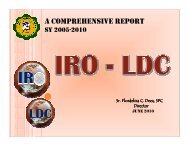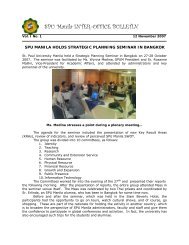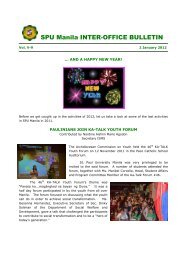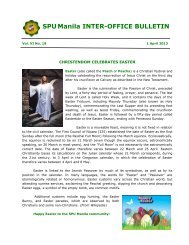Sr. Flordeliza Deza, SPC - St. Paul University Manila
Sr. Flordeliza Deza, SPC - St. Paul University Manila
Sr. Flordeliza Deza, SPC - St. Paul University Manila
You also want an ePaper? Increase the reach of your titles
YUMPU automatically turns print PDFs into web optimized ePapers that Google loves.
THE CHILE EXPERIENCE<br />
Documenting and Understanding<br />
the Factors that Enhance and/or<br />
Inhibit Post-First Language Learning<br />
in the SPU <strong>Manila</strong> Environment<br />
<strong>Sr</strong>. <strong>Flordeliza</strong> <strong>Deza</strong>, <strong>SPC</strong><br />
Director, International Relations Office<br />
and Language Development Center<br />
Brian Bantugan, PhD<br />
Former Director, SPUM Institutional<br />
Research and Planning Office
Two Phenomena:<br />
1. Globalization and<br />
internationalization<br />
- English as lingua franca<br />
- internationalization of campuses<br />
* 2006: SPUM establishes the IRO-LDC<br />
• 2. Chile Ministry of Education - 2008<br />
“English Opens Doors Program”
HON.CONSUELO PUYAT-REYES<br />
AMBASSADOR TO CHILE, PERU AND ECUADOR<br />
MS. WYNNA MARIE MEDINA, PRESIDENT, SPUM<br />
SR. FLORDELIZA DEZA, <strong>SPC</strong><br />
DIRECTOR, IRO-LDC<br />
CARMEN ORIA-GARRIZ<br />
Coordinator, English<br />
Opens Doors Program<br />
HON. CRISTINA PONCE ENRILE<br />
Amb. to the Vatican<br />
MOA SIGNING<br />
DR. RICARDO FABREGA<br />
OF THE CHILEAN MINISTRY OF<br />
EDUCATION
INTENSIVE ESL/TESL PROGRAM (when east meets west?)<br />
U. Santo Tomas – Antofagasta U. Santo Tomas - Temuco<br />
The PARTICIPANTS:<br />
EDUCATION STUDENTS from the<br />
UNIVERSIDAD DE SANTO TOMAS , CHILE<br />
Bernardo Barrientos Bonilla Romina Paez Rojas Mabel Cardenas Bravo<br />
U. Santo Tomas – Santiago<br />
June 2008<br />
Nicole Lacourt Herrera Grace Garcia-Huidobro Moreno Ivon Lopez Avi Viviana Riquelme Cea Daniela Paz Inguerzon Anahi Rojas Diaz<br />
U. Santo Tomas – Viña del Mar<br />
Gustavo Maldonado Camila Jeria Diaz Ximena Montino Briones Margarita Zamora Alvarado Carolina Lazcano Herrera Guillermo Diaz<br />
Meneses<br />
Rodriguez
Purpose of this study:<br />
To look back at the whole experience to derive learnings<br />
that could enhance SPUM’s modes of delivery in teaching<br />
English to non-Asians, and in helping others to enhance<br />
their own language learning programs with a greater<br />
understanding of factors that assist or inhibit language<br />
learning in different cultural groups.
Related Literature<br />
Second Language vs. Foreign Language Learning.<br />
Masgoret and Gardner, 2002 distinguished bet. second and<br />
foreign language learning<br />
Foreign language learning in childhood vs. adulthood.<br />
Bley-Vroman, 1990 posted the possibility that the innate<br />
system which guides child acquisition no longer operates in<br />
adult foreign language learning (or more weakly, hence the<br />
increasing difficulty of an adult to learn a foreign language.)<br />
Second Language Learning in adult learners and<br />
negotiation. Pica, 1994, posited “negotiation “as an approach<br />
that facilitates better second language learning, that the actual<br />
use of the second language in less formal interactions enhance<br />
an adult’s competence in it.
Individual factors affecting language learning among<br />
adults.<br />
Oxford and Nyikos, 2002 reported that successful<br />
language learners generally use strategies appropriate to<br />
their own stage of learning, personality, age, purpose for<br />
learning the language, and type of language.<br />
Masgoret and Gardner’s (2002) socio-educational model<br />
of second language acquisition recognizes the impact of<br />
attitude and motivation in second language learning,<br />
where one must consider the primacy of individual will<br />
and desire over external conditions in determining<br />
second language learning - which could be applied to the<br />
Chilean experience.
Synthesis:<br />
The above literature suggest that the Chileans in<br />
the SPU <strong>Manila</strong> program are in a peculiar<br />
situation: their age, the limited exposure to what<br />
could have been their second language in Chile<br />
(English), and their learning locale (Philippines)<br />
where English, while it is the language of<br />
instruction, is not the mother tongue outside the<br />
classroom, thus placing natural limits in learning<br />
English as a second language.
<strong>St</strong>udy Framework<br />
Bernard Spolsky’s theory (1989) “Conditions for Second<br />
Language Learning” is used as a framework to describe<br />
the Intensive English Program for Education <strong>St</strong>udents from<br />
Chile in SPU <strong>Manila</strong>.<br />
The theory expresses second language learning as<br />
the sum of four elements expressed in the ff.<br />
formula:<br />
Kf = Kp + A + M + O
“Kf” : knowledge and skills at some future time,<br />
results from the contributions of<br />
“Kp”: knowledge and skills prior to the language<br />
learning;<br />
“A” : the various components of ability<br />
consisting of the physiological, biological,<br />
intellectual, and cognitive skills;<br />
“M” : affective factors which includes personality,<br />
attitudes, motivation, and anxiety);<br />
“O” : opportunity for learning the language (of<br />
formal and non-formal situations exposing<br />
the learner to the second language).
Kf = Kp + A + M + O<br />
Kf : end-of-term grade given by their instructors; considered<br />
positive if it is above the marks in a pre-program test.<br />
Kp : pre-program test results, deemed positive if it is within<br />
average or higher range.<br />
A<br />
: considered positive if the various components necessary<br />
for language learning are to be found, whether or not they<br />
show low or high competence levels in Kp.<br />
M<br />
O<br />
: more qualitative than quantitative in nature, is considered<br />
positive if it is generally optimistic; negative if otherwise.<br />
:reflected by the kinds of activities provided and the<br />
ratings given them by the students; it is considered<br />
positive if the activities were graded within acceptable<br />
range, and negative if otherwise.
The study describes the program based on the<br />
constituent elements of Kf.<br />
Gardner’s socio-educational model of second language<br />
acquisition is essentially part of the “M” in the above<br />
equation. Masgoret and Gardner (2002) defines M as<br />
constituted by motivation or “Mo”, attitudes<br />
(integrativeness and attitudes towards the learning<br />
situation = or “At”), and orientation (integrative<br />
orientation and instrumental orientation or “Or”).<br />
Motivation is defined by them as goal-directed behavior.<br />
The goal here is to learn English. Thus, motivation is<br />
considered positive if behaviors manifested in the<br />
program show a desire to learn English.
Meanwhile, attitude, consists of (1) integrativeness<br />
[or “an openness to identify with another language<br />
community, … that would facilitate their motivation to<br />
learn” (p. 172)], and (2) attitude towards the learning<br />
situation.<br />
The former is divided into three major areas,<br />
namely, attitude towards the target language<br />
group; interest in learning the language “in order<br />
to interact, meet, socialize, become friends, etc.,<br />
with members of the other community” (p. 172);<br />
and interest in foreign languages or simply a<br />
general openness to all groups.
The latter, points to “the individual’s reaction<br />
to anything associated with the immediate<br />
context in which the language is taught… (or)<br />
relative to others in class ” (p. 172-173) which<br />
may be gauged through evaluation of the<br />
course and evaluation of the teacher. These<br />
two attitudes, taken together with motivation,<br />
constitute what is called “integrative<br />
motivation.”
Thus, orientation to language study is made up<br />
of integrative orientation [“reasons for learning<br />
a second language that emphasize the notion of<br />
identification with the community” (p. 174)] and<br />
instrumental orientation [or the “practical<br />
reasons for learning the language without<br />
implying any interest in getting closer socially<br />
to the language community” (p. 175)].<br />
Thus, the Spolsky equation is modified here as:<br />
Kf = Kp + A + (Mo + At + Or) + O
METHODOLOGY<br />
The study was designed as qualitative and quantitative description of<br />
the Intensive English Program for Education <strong>St</strong>udents from Chile.<br />
“Kf” : acquired from the grades or quantitative performance<br />
appraisal of the Chilean students by their teachers.<br />
“Kp”: derived from the results of the ‘Test of Adolescent and Adult<br />
Language (TOAL-3) administered upon their arrival and the<br />
Teaching Aptitude Test given after the program.<br />
“A” : acquired from the various components of the Test of<br />
Adolescent and Adult Language (TOAL-3) prior to the start of<br />
the program, Teaching Aptitude Test administered to them<br />
after their practicum, and the written feedback which they<br />
submitted after completing the program.<br />
“M” : derived from their narrative reports regarding their experiences<br />
submitted at the end of the program and the End-of-Program<br />
Evaluation Results (for the course offerings and teachers).<br />
“O” : was constituted by the program content on which the postprogram<br />
evaluations were based.
Results and Discussions<br />
Kf or Knowledge and skills after 5 months.<br />
After the program, it was apparent that most, if<br />
not all, had the capacity to teach English or teach<br />
in English by the time they are sent to the field.<br />
The students were graded very high and<br />
individual marks range from 82 (average) to 98<br />
(excellent), indicating that their knowledge and<br />
skills, as assessed by their teachers in the<br />
program, have been considered acceptable, if<br />
not exceptional.
In the area of teaching aptitude, they rated “average”,<br />
at best (<strong>St</strong>anine at 4 with raw score 65-76); one<br />
received a “poor” mark (<strong>St</strong>anine at 1 with raw score<br />
37) which was more the exception than the rule.<br />
Qualitatively, they indicated some memorable learning<br />
experiences that impact on their behavior. A number<br />
of the Chileans mentioned<br />
learning how to do the lesson plan as a peak learning<br />
experience related to practicum.<br />
The individual feedback that point to a more<br />
systematic way of preparing for a class are as follows:
“ I enjoyed knowing how teachers are able to develop a<br />
class in a short period of time.<br />
I was able to develop a class in the English language.<br />
I learned a lot like how to prepare a lesson plan, how to<br />
create a good environment inside the classroom, and how I<br />
want to be with my students when I return to Chile.<br />
I started to work very hard to make a lesson plan.<br />
I learned a lot on how to plan a lesson because the format<br />
the school follows is simple and complete.<br />
I learned to prepare a lesson plan, how to develop a lesson,<br />
how to create an appropriate power point, and how to deal<br />
with a big class of 40 students inside a classroom.”
Others mentioned the ability to manage a large class, facilitate<br />
group work, or encourage students to work by themselves.<br />
They admitted:<br />
I think I could really manage the class.<br />
I learned that if you want to be successful with the activities,<br />
you, as a teacher, need to be active and dynamic, and also<br />
create activities with a lot of movements.<br />
I learned how to really apply group work and make the<br />
students work by themselves.<br />
I learned to “remember” the names of students (which make<br />
them ) feel that they are important to us.
A few stated learning more about themselves which raises<br />
them to a higher consciousness level necessary in achieving.<br />
I am able to do every challenge even though it looks difficult.<br />
I was able to teach them and I could also learn from my<br />
students.<br />
I realized that I could use some background information from<br />
my country .”<br />
The above statements signify that while the numbers don’t<br />
speak well about their teaching aptitude, their narratives talk<br />
about new learnings and skills related to teaching that bring<br />
them to a level better than where they were when they started.<br />
Hence, their language learning seemed to be more progressive<br />
than their teaching skills but the latter seems to be improving as<br />
a result of greater confidence in performing it.<br />
As such, Kf is considered to be positive overall.
“Kp” or knowledge and skills prior to language<br />
learning.<br />
The test results in TOAL–3 reveal below average to,<br />
mostly poor and very poor general marks,<br />
specifically in the area of listening vocabulary and<br />
speaking grammar.<br />
This indicated that opportunities to listen to English<br />
words and to speak in English, were barely<br />
provided in their own country. If any, they were<br />
more competent reading the grammar and writing<br />
the words – indicating more passive and leisurely<br />
language learning activities.
Table 1. TOAL-3 Scores at the beginning of the Program<br />
Listening Speaking Reading Writing General<br />
Vocabulary Grammar Vocabulary Grammar Vocabulary Grammar Vocabulary Grammar<br />
1 Poor (P) Below<br />
Average<br />
(BA)<br />
Average (A)<br />
Very Poor<br />
(VP)<br />
BA A A P P<br />
2 P A P VP BA A A P P<br />
3 P A P VP BA A A P P<br />
4 BA A A VP A A A A BA<br />
5 P A VP VP BA A BA BA VP<br />
6 P A VP VP BA A A BA P<br />
7 BA A A VP A A BA A BA<br />
8 VP A VP BA A A A A P<br />
9 P A P VP BA A A A P<br />
10 P BA BA VP BA A A A P<br />
11 P A BA VP A A A A BA<br />
12 P A VP VP BA A P BA VP<br />
13 VP A VP VP P BA P P VP<br />
14 P A VP VP A BA BA BA P<br />
15 P A VP VP A A BA BA P
“A” or ability to learn the second language.<br />
Below is the list of abilities that were tested in the<br />
participants where most participants received below<br />
average marks at best. In the area of second language<br />
learning, the skills required are as follows:<br />
Listening/vocabulary<br />
Listening/grammar<br />
Speaking/vocabulary<br />
Speaking/grammar<br />
Reading/vocabulary<br />
Reading/grammar<br />
Writing/vocabulary<br />
Writing/grammar
In the area of teaching, the aspects below were deemed<br />
crucial and measurable. In most cases they were found to<br />
be below average although their remarks reveal<br />
enthusiasm, especially after having gone through their<br />
practice teaching in <strong>St</strong>. <strong>Paul</strong> College Pasig.<br />
Judgment in teaching situations<br />
Reasoning and information concerning school problems<br />
Comprehension and retention<br />
Nevertheless, the odds in second language learning among<br />
the Chilean students seem to be greater in that their level<br />
of competence, age, and the locale (which does not use<br />
English as a mother tongue) are burdens they carry as they<br />
go through the program.<br />
Hence, A is deemed a negative here overall.
“M” or motivation, attitudes, and orientation<br />
Motivation. In the area of motivation, the students revealed a<br />
desire to learn English. Some were generally looking for skillsimprovement<br />
as stated below:<br />
To improve my language skills<br />
Improve my English skills<br />
To improve my English skills in an Englishspeaking<br />
country<br />
Others were looking at skills enhance in the context of<br />
professional development, as expressed below:<br />
We came here to study a program for English teachers.
A few indicated a desire to belong or experience another<br />
culture.<br />
<strong>St</strong>udying, increasing my English vocabulary,<br />
challenging myself to live in a foreign country<br />
One revealed a desire to improve self and test his/her<br />
limits<br />
Overall, it is clear to most, if not all, that they were in the<br />
program primarily in response to their desire to learn<br />
English.<br />
Thus, the motivation of the group is generally positive.
Attitudes: Integrativeness<br />
Attitude towards the target language group. Some<br />
expressed a desire to engage with the receiving culture,<br />
which recognizes its value in the learning process. One<br />
specifically noted such openness by admitting a desire<br />
to gain:<br />
(C)onfidence to talk and share with others and also be<br />
part of another culture<br />
Interest in learning the language “in order to interact,<br />
meet, socialize, become friends, etc., with members of<br />
the other community<br />
“Learn the culture… make new friends
Interest in foreign languages … which interest was more<br />
focused on English than any other language. There was<br />
no specific desire for Filipino language.<br />
Evaluation of the course<br />
The students rated the achievement of objectives of the<br />
course at 4.28 on a scale of 1 to 6 (6 as the highest).<br />
They rated the relevance of the course to their careers at 5.6<br />
using the previous scale.<br />
Hence, there is an overall positive attitude towards the<br />
course. This is reflected in what one student said about the<br />
program:<br />
The program included interesting subjects which helped<br />
me.
Evaluation of the teacher.<br />
The teachers were given a general average rating of 5,<br />
(where 6 is highest). One teacher was rated 6.<br />
The aspect of the teacher given the lowest rating of 4 was<br />
quality of tasks/reading materials. However, the aspects<br />
that received the highest mark of 6 were knowledge of<br />
the subject, willingness to respond to questions and<br />
encourage discussions, and quality of tasks/reading<br />
materials. Thus, there was an overall positive attitude<br />
on the teachers. Quotes from the students:<br />
We had good teachers and I really enjoyed each class.<br />
I got the best from all classes I have had here.<br />
The experience with the teachers was good except for<br />
some problems with two of our teachers.
In the case of non-classroom learning experiences, more<br />
negative attitudes focused on accommodations, utilities<br />
and quality of service delivered by elders or staff whom<br />
they interact with outside of the classrooms.<br />
A student emphasized the importance of being able to<br />
separate the professional from the personal, which they<br />
expected from those helping them in the program. Despite<br />
some miscommunications and frustrations, the Chileans<br />
were able to separate the non-academic from the academic<br />
programs, and hence, the evaluations of the teacher and<br />
course were found to be not affected by any negative<br />
experiences during their 5-month stay. Thus, they could say:<br />
This program has been excellent because of the teachers.<br />
I learnt a lot and I have been practicing my English outside<br />
and inside the classroom.
Orientation<br />
Integrative orientation or reasons for learning a second<br />
language that emphasize the notion of identification with the<br />
community. This is an aspect which clearly overlaps with<br />
motivation, specifically, integrativeness.<br />
Because most of the students were expecting to go to the US or<br />
Europe, they did not express any general desire to identify with<br />
Filipinos. In fact, one thought being in the Philippines was<br />
negative because the “Filipinos speak most of the time in their<br />
native tongue.” Another confided, “as (the) Philippines’ first<br />
language is not English, you should not bring more students)<br />
to learn it (English) here because they would face the same<br />
problem… it is not a good experience just listening (to) Tagalog<br />
instead of good English, which was my purpose (in coming).”
<strong>St</strong>ill another felt not being understood enough by the<br />
receiving country, and noted, “People in charge should<br />
take into account the background of the students, at<br />
least knowing where the country is.”<br />
Overall, their sense of displacement, having been more<br />
oriented towards visiting a more English-speaking<br />
country, led to a sense of disorientation. Furthermore,<br />
not having bonded prior to their arrival in the<br />
Philippines, hostilities among Chilean students got in<br />
the way of a real community spirit among them, later<br />
hindering a more desirable relationship with Filipinos,<br />
despite less than positive learning conditions.<br />
This aspect of orientation, then, seems to be more<br />
negative than positive.
Instrumental orientation or practical reasons for<br />
learning the language without implying any interest<br />
in getting closer socially to the language community.<br />
This, too, is closely connected to motivation in that<br />
their motivation to learn English is attached to a<br />
clear purpose, primarily, for the immediate goal of<br />
self-improvement, and secondly, for professional<br />
development. The strong motivation to learn English<br />
in the US may be considered fueled by having been<br />
previously oriented to teach in English, if not teach<br />
English.
Thus, this aspect is more positive in that<br />
identification with Filipinos is not part of it.<br />
Since the orientations that were made manifest<br />
here are associated with positive motivations<br />
that were previously noted, one would likely say<br />
that instrumental orientation seemed to have<br />
compensated for whatever negatives were found<br />
in integrative orientation and driven motivation to<br />
learn English in the Philippines overall.
“O” or opportunity for learning.<br />
Opportunities for holistic learning were provided -<br />
consistent with the approach of <strong>Paul</strong>inian education in the<br />
Philippines. The learning opportunities included classroom<br />
instructions and non-classroom activities. The<br />
classroom instruction was guided by international<br />
standards in English language teaching and learning.<br />
To complement what one student has found to be<br />
“extremely intensive” training, non-academic activities<br />
were also included. There were spiritual growth<br />
opportunities provided which most of them preferred not<br />
to participate in, except for the reflective synthesis at the<br />
end of the program. Thus, the program was largely<br />
academic in nature and cultural activities that have been<br />
formally arranged for them functioned as alternative<br />
learning experiences.
Classroom-based Opportunities<br />
Speech (Phonology)<br />
Reading<br />
Functional Grammar<br />
Language Learning and Teaching<br />
Communicative Language Teaching<br />
Teaching the Four Macro Skills<br />
Content-based Language Instruction<br />
Designing and Preparing Instructional Materials<br />
Using Technology Effectively in the Classroom<br />
Practice Teaching<br />
Classroom Language Testing and Assessment<br />
Special Courses – Phil. Culture, Research
Off-Classroom-based Opportunities<br />
Dormitory<br />
Interaction with <strong>Paul</strong>inians,<br />
Participation in university and other events<br />
Cultural and recreational tips<br />
Journal writing<br />
Total immersion<br />
In general, it seemed that the off-classroom-based<br />
opportunities were not so appreciated and posed<br />
the greatest challenge, esp. in view of the<br />
weather/climate and dormitory facilities and<br />
services.
Some of the Chilean students’ comments:<br />
The weather was the most difficult here. - very warm.<br />
I wanted to (go) back (to Chile) because it was too hot<br />
and I felt sick.<br />
Too many people.<br />
A real challenge to me (was) to adapt to a new culture.<br />
Nobody speaks good English here. They are speaking in<br />
another language I don’t know.<br />
I think it has been a little difficult to study here because<br />
most of the time people don’t understand what we want,<br />
even though people here have tried to help…<br />
Maybe the biggest issue here has been that people don’t<br />
tend to separate their profession from personal issues.
The strong negative attitude against the weather or<br />
the dormitory staff and other Filipinos not being<br />
able to speak like the native English showed their<br />
inability to go beyond their physical discomforts<br />
and their cultural biases against the Philippines,<br />
which they resented as they were expecting to go to<br />
the US instead.<br />
Eight of the 15 students were also clearly not<br />
willing to adapt with Filipinos and their peers since<br />
an incident among them reflected their hostility<br />
towards the other Chilean students who were more<br />
able to adapt to the conditions in the Philippines.
Thus, classroom provisions were seen positive compared<br />
to the off-campus which seemed to be more negative.<br />
Nevertheless, after having<br />
seen the positive evaluations<br />
on the over-all opportunities<br />
given them, the classroom<br />
experiences seem to be<br />
compensating for the<br />
off-classroom provision<br />
resulting in a more<br />
positive overall mark<br />
for O or opportunity<br />
for learning.
Synthesis<br />
Taking into account the positives and negatives that were seen<br />
in each element of the equation Kf = Kp + A + (Mo + At + Or) + O,<br />
where Kp took on a negative weight and, and A, M, and O were<br />
generally positive and contributed to a positive Kf, the equation<br />
below arises as reflective of SPU <strong>Manila</strong> experience.<br />
(+) Kf = (-) Kp (-) A + [(+) Mo (+) At (+) Or] (+) O<br />
In general, the positive Kf was brought about by the positive<br />
motivation, attitude to the learning situation, and instrumental<br />
orientation found within M, and classroom-based opportunities<br />
to learn English. These overcame the odds that were coming<br />
from a negative Kp, a low A or ability to learn English in the<br />
Philippines, negative integrativeness attitude and integrative<br />
orientation found within M, and negative O manifested in<br />
negative feedback on off-classroom learning experiences.
Conclusions:<br />
The high points of the program were found in the positive<br />
motivation, attitude to the learning situation, and instrumental<br />
orientation found within M, and classroom-based opportunities to<br />
learn English;<br />
while the low points were found in the low ability to learn English<br />
in the Philippines, negative integrativeness attitude and<br />
integrative orientation found within M, and negative O manifested<br />
in negative feedback on off-classroom learning experiences.<br />
The high points enhanced learning, the low points theoretically inhibit<br />
learning. However, in the final analysis, the Chilean experience as shown<br />
in the over-all evaluation, the experience of language learning in the<br />
Philippines yielded positive results – even as the Chilean students had to<br />
struggle with the limits they found in the off classroom experiences and<br />
issues within and among themselves.
RECOMMENDATIONS:<br />
1. Further strengthen the courses offered and<br />
the preparation of teachers and staff handling<br />
foreign students.<br />
2. Improve facilities particularly dormitory<br />
services<br />
* 3. Accept students with the proper<br />
motivations, attitudes, and orientations.
This requires that sending countries like Chile to -<br />
1) Choose candidates with proper motivation,<br />
capacity to adjust to other cultures and with<br />
minimal issues of integration.<br />
2) Orient their students about the country of<br />
destination, like the Philippines, so that they<br />
do not expect more than what it can offer as<br />
an English-learning environment.
References<br />
Ble-Vroman, R. (1990). The Logical Problem of Foreign Language Learning. Linguistic Analysis, 20 (1-2), 3. Retrieved<br />
from<br />
http://www.google.com/books?hl=tl&lr=&id=E3Z_O2Jjou8C&oi=fnd&pg=PA41&dq=language+learning+environment&ots<br />
=KGoYMjz4u7&sig=5A5rC_XN7cHXrmJJ99rtzFQ-#v=onepage&q=language%20learning%20environment&f=false<br />
Ervin-Tripp, S. (1974). Is Second Language Learning Like the First. TESOL Quarterly 8 (2), 111-127.<br />
Johnson, J. S. and Newport, E. (1989). Critical Period Effects in Second Language Learning: The Influence of<br />
Maturational <strong>St</strong>ate on the Acquisition of English as a Second Language. Cognitive Psychology 21, 60-99. Retrieved from<br />
http://www.psy.cmu.edu/~siegler/JohnsnNewprt89.pdf.<br />
Masgoret, A. and Gardner, R. (2002). Attitudes, Motivation, and Second Language Learning: A Meta-Analysis of <strong>St</strong>udies<br />
Conducted by Gardner and Associates. Retrieved from http://users.telenet.be/cr32258/Attidus%20motivation%20L2.pdf<br />
Oxford, R. and Nyikos, M. (2002). Variables Affecting Choice of Language Learning <strong>St</strong>rategies<br />
by <strong>University</strong> <strong>St</strong>udents. Annual Conference on Research Perspectives in Adult Language Learning and Acquisition.<br />
November 3-4, 1989. Columbus, Ohio. Retrieved from http://www.jstor.org/pss/327003.<br />
Peirce, B. (1995). Social Identity, Investment, and Language Learning. TESOL Quarterly, 29 (1), 9-31. Retrieved from<br />
http://www.lerc.educ.ubc.ca/fac/norton/TQ%20%281995%29%20-<br />
%20Social%20identity,%20investment,%20and%20language%20learning.pdf.<br />
Pica, T. (1994). Research on Negotiation: What Does It Reveal About Second-Language Learning Conditions,<br />
Processes, and Outcomes?. Language Learning 44 (3), 493-527. Retrieved from<br />
http://www.uwec.edu/ESL/minors/TESOL/FLG378picaNegotiation%20of%20Meaning%20Overview.pdf.<br />
Ravem, R. (1968). Language Acquisition in a Second Language Environment. IRAL, 6 (2), 175-85. Retrieved from<br />
http://eric.ed.gov/PDFS/ED025978.pdf.<br />
Sluijmans, D. , Dochy, F., and Moerkerke, G. (2006). Creating a Learning Environment by Using Self-, Peer- and<br />
Co-Assessment. Learning Environments Research 1 (3), 293-319. DOI: 10.1023/A:1009932704458<br />
Spolsky, B. (1998). Conditions for Second Language Learning. NY: Oxford <strong>University</strong> Press.<br />
Retrieved from<br />
http://faculty.ksu.edu.sa/Magda/Supporting%20Teaching%20Materials/Educational%20Materials/Theory%20of%20secon<br />
d%20language.pdf
Interaction with<br />
<strong>Paul</strong>inians and<br />
other<br />
international<br />
students
Cultural/recreational trips
LANGUAGE LEARNING -<br />
Where East Meets West!
THE CHILE EXPERIENCE<br />
Documenting and Understanding<br />
the Factors that Enhance and/or<br />
Inhibit Post-First Language Learning<br />
in the SPU <strong>Manila</strong> Environment<br />
<strong>Sr</strong>. <strong>Flordeliza</strong> <strong>Deza</strong>, <strong>SPC</strong><br />
Director, International Relations Office<br />
and Language Development Center<br />
Brian Bantugan, PhD<br />
Former Director, SPUM Institutional<br />
Research and Planning Office

















